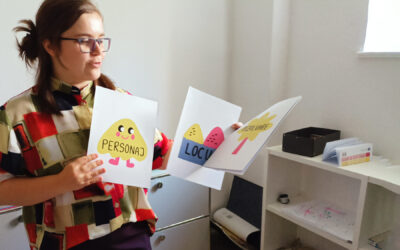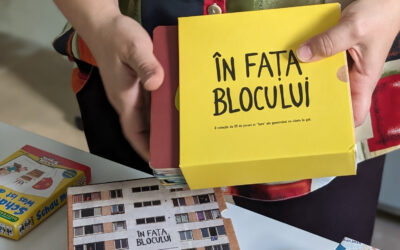Sand Storytelling
Sand Storytelling
Let children be creative with kinetic sand as they explore textures, create shapes and bring their own imaginative stories to life with sand and cardboard characters in this interactive storytelling activity.
20-30 min
2-6 years old
1-10 ppl
Children can develop fine motor skills, sensory awareness, and language abilities as they explore the sand’s texture. They can make their own stories and share them with others. They can also learn new words and ideas about nature.
Language Skills
A1 – A2
Kinetic sand, a “magic” bag with cardboard characters (3 characters per child).

Languages Available
- Introduction to the activity:
- Gather the children around a large table or on the floor, where they can all reach the kinetic sand.
- Explain that today, they will use sand to create magical stories together.
- Exploring the sand:
- Give each child some kinetic sand. Encourage them to touch, squeeze, and shape the sand, explaining how it can become anything they imagine.
• Begin a guided play session where the facilitator describes different natural elements. For example: - “Can you make it rain with the sand?” (Let the sand fall between their fingers like raindrops.)
•“Let’s create a waterfall.” (Move the sand as if it’s flowing water.
•“Can you imagine the ocean?” (Flatten the sand to resemble the sea.) - As you go through each of these, have the children repeat key words aloud (e.g., “rain,” “waterfall,” “ocean”) to reinforce the storytelling atmosphere.
- Building with sand:
- After playing with the sand, encourage the children to create small shapes or structures. Ask them to describe what they’ve built. For example, “What is that you made from sand? Is it a mountain or maybe a castle?”
- Magic Bag – Choosing Characters:
- Introduce the “Magic Bag” filled with cardboard characters.
• Let each child take turns pulling out three characters from the bag. - Encourage them to describe who their characters are (e.g., “I have a dragon, a princess, and a wizard.”).
- Creating a story:
- Now that they have their sand structures and characters, guide the children to create their own short story. Encourage them to think about how their characters interact with what they’ve built from sand.
- Give examples to help spark ideas, such as: “Maybe your dragon is guarding the sandcastle? Or perhaps the princess is sailing across the sand sea?”
- Storytelling Time:
- Once the children have finished creating their sand scenes, go around the group and let each child briefly share their story.
- Encourage them to use the key words they learned earlier (rain, waterfall, ocean) and point to their sand creations while telling their tale.
- Closing the activity:
- Thank the children for their creativity and remind them how they used both sand and imagination to create their stories.
- Collect the characters and begin the transition to the next activity.

For Educators & Teachers
Preparation
Make sure there is enough kinetic sand and cardboard pictures for all the children in the group. Cardboard pictures can be replaced with plastic/wooden figures of an age-appropriate size and shape (e.g. not too small for small children to swallow, no sharp edges, etc.). Can be made with the children before the activity if their skills allow.
Expected output
An expected outcome of the activity is for each child to create a small sand structure or scene, along with a short, imaginative story that includes the characters they have chosen and the elements they have created in the sand. These stories, shared with the group, may include descriptive language using the nature-based vocabulary introduced (e.g. rain, ocean, waterfall). In addition, the children may become more comfortable with storytelling and demonstrate engagement in cooperative play as they interact with each other’s stories and creations.
Adaptation/Application of the method
1. Different Language Levels
Use Visual & Tactile Support: Demonstrate words through gestures or by shaping the sand yourself.
Encourage Multilingual Storytelling: Allow children to name their objects or characters in their native language and share translations if possible.
Simplify & Expand Vocabulary: Offer easy words for beginners while challenging advanced speakers with descriptive storytelling prompts.
2. Group Dynamics
Encourage Turn-Taking: Assign clear roles (e.g., one child builds, another narrates) to ensure equal participation.
Balance Introverted & Extroverted Children: Let quieter children show their story visually if they’re hesitant to speak.
Pair or Small Groups: If the group is large, have children work in pairs or small teams to prevent overwhelming interactions.
3. Cultural Sensitivity
Diverse Character Choices: Ensure the “Magic Bag” includes characters from different cultures and backgrounds.
Avoid Cultural Stereotypes: Encourage children to create their own versions of stories rather than following fixed fairy-tale roles.
4. Physical Space Limitations
Adjust for Small Areas: Use trays or mats to keep the sand contained when floor space is limited.
Flexible Seating Arrangements: If a table is unavailable, let children sit in a circle on the floor for accessibility.
Alternative Materials: If kinetic sand is unavailable, use other sensory materials like modeling clay or make a DIY kinetic sand.
5. Attention Span & Engagement
Keep Instructions Short & Clear: Break down the activity into small steps to maintain focus.
Vary the Tasks: Mix movement, storytelling, and building to keep energy levels balanced for very small children.
6. Children with Mobility Challenges
Ensure Easy Access: Place sand on low trays or use containers that are reachable from a seated position.
Encourage Verbal or Creative Contributions: If a child cannot physically manipulate the sand, they can direct a partner or describe their ideas instead.
Developed by / Origin / Original language
Marinessa Radchenko, Koopkultur e.V. / Ukraine, Germany / Ukrainian, Russian
References, and Resources
Kinetic Sand DIY: https://eatingrichly.com/kinetic-sand-recipe/
Find free/Paid characters to download: https://www.freepik.com/
Similar Activities
Ma première histoire
This fun activity for all ages uses storytelling and a simple card game to help children develop language skills, creativity, and self-confidence by reading, identifying story elements, and creating their own stories
My First Story English Only
This fun activity for all ages uses storytelling and a simple card game to help children develop language skills, creativity, and self-confidence by reading, identifying story elements, and creating their own stories


